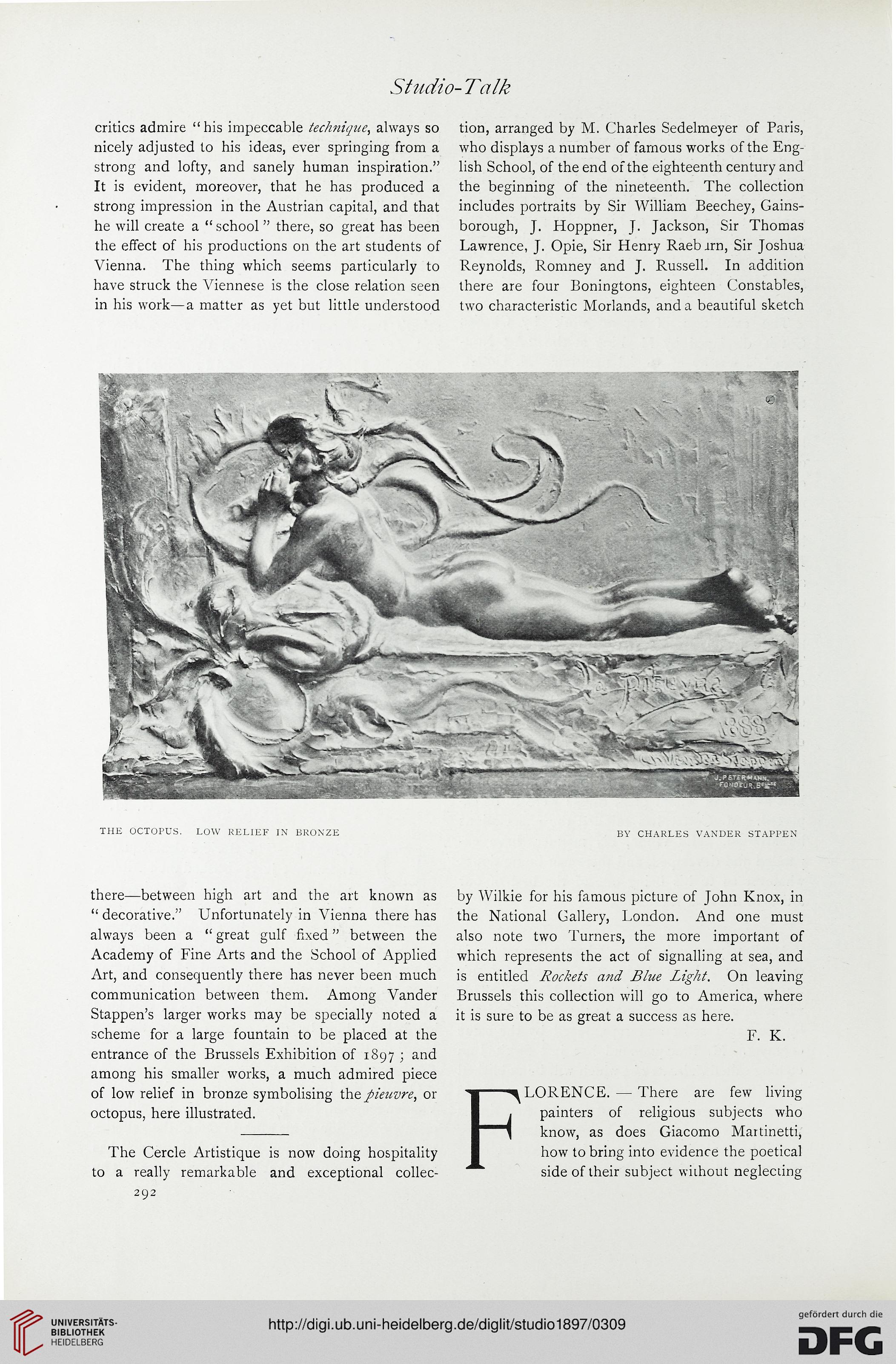Studio- Talk
critics admire " his impeccable technique, always so
nicely adjusted to his ideas, ever springing from a
strong and lofty, and sanely human inspiration."
It is evident, moreover, that he has produced a
strong impression in the Austrian capital, and that
he will create a " school " there, so great has been
the effect of his productions on the art students of
Vienna. The thing which seems particularly to
have struck the Viennese is the close relation seen
in his work—a matter as yet but little understood
tion, arranged by M. Charles Sedelmeyer of Paris,
who displays a number of famous works of the Eng-
lish School, of the end of the eighteenth century and
the beginning of the nineteenth. The collection
includes portraits by Sir William Beechey, Gains-
borough, J. Hoppner, J. Jackson, Sir Thomas
Lawrence, J. Opie, Sir Henry Raebirn, Sir Joshua
Reynolds, Romney and J. Russell. In addition
there are four Boningtons, eighteen Constables,
two characteristic Morlands, and a beautiful sketch
there—between high art and the art known as
" decorative." Unfortunately in Vienna there has
always been a " great gulf fixed" between the
Academy of Fine Arts and the School of Applied
Art, and consequently there has never been much
communication between them. Among Vander
Stappen's larger works may be specially noted a
scheme for a large fountain to be placed at the
entrance of the Brussels Exhibition of 1897 ; and
among his smaller works, a much admired piece
of low relief in bronze symbolising the pieuvre, or
octopus, here illustrated.
The Cercle Artistique is now doing hospitality
to a really remarkable and exceptional collec-
292
by Wilkie for his famous picture of John Knox, in
the National Gallery, London. And one must
also note two Turners, the more important of
which represents the act of signalling at sea, and
is entitled Rockets and Blue Light. On leaving
Brussels this collection will go to America, where
it is sure to be as great a success as here.
F. K.
FLORENCE. — There are few living
painters of religious subjects who
know, as does Giacomo Martinetti,
how to bring into evidence the poetical
side of their subject wiihout neglecting
critics admire " his impeccable technique, always so
nicely adjusted to his ideas, ever springing from a
strong and lofty, and sanely human inspiration."
It is evident, moreover, that he has produced a
strong impression in the Austrian capital, and that
he will create a " school " there, so great has been
the effect of his productions on the art students of
Vienna. The thing which seems particularly to
have struck the Viennese is the close relation seen
in his work—a matter as yet but little understood
tion, arranged by M. Charles Sedelmeyer of Paris,
who displays a number of famous works of the Eng-
lish School, of the end of the eighteenth century and
the beginning of the nineteenth. The collection
includes portraits by Sir William Beechey, Gains-
borough, J. Hoppner, J. Jackson, Sir Thomas
Lawrence, J. Opie, Sir Henry Raebirn, Sir Joshua
Reynolds, Romney and J. Russell. In addition
there are four Boningtons, eighteen Constables,
two characteristic Morlands, and a beautiful sketch
there—between high art and the art known as
" decorative." Unfortunately in Vienna there has
always been a " great gulf fixed" between the
Academy of Fine Arts and the School of Applied
Art, and consequently there has never been much
communication between them. Among Vander
Stappen's larger works may be specially noted a
scheme for a large fountain to be placed at the
entrance of the Brussels Exhibition of 1897 ; and
among his smaller works, a much admired piece
of low relief in bronze symbolising the pieuvre, or
octopus, here illustrated.
The Cercle Artistique is now doing hospitality
to a really remarkable and exceptional collec-
292
by Wilkie for his famous picture of John Knox, in
the National Gallery, London. And one must
also note two Turners, the more important of
which represents the act of signalling at sea, and
is entitled Rockets and Blue Light. On leaving
Brussels this collection will go to America, where
it is sure to be as great a success as here.
F. K.
FLORENCE. — There are few living
painters of religious subjects who
know, as does Giacomo Martinetti,
how to bring into evidence the poetical
side of their subject wiihout neglecting




